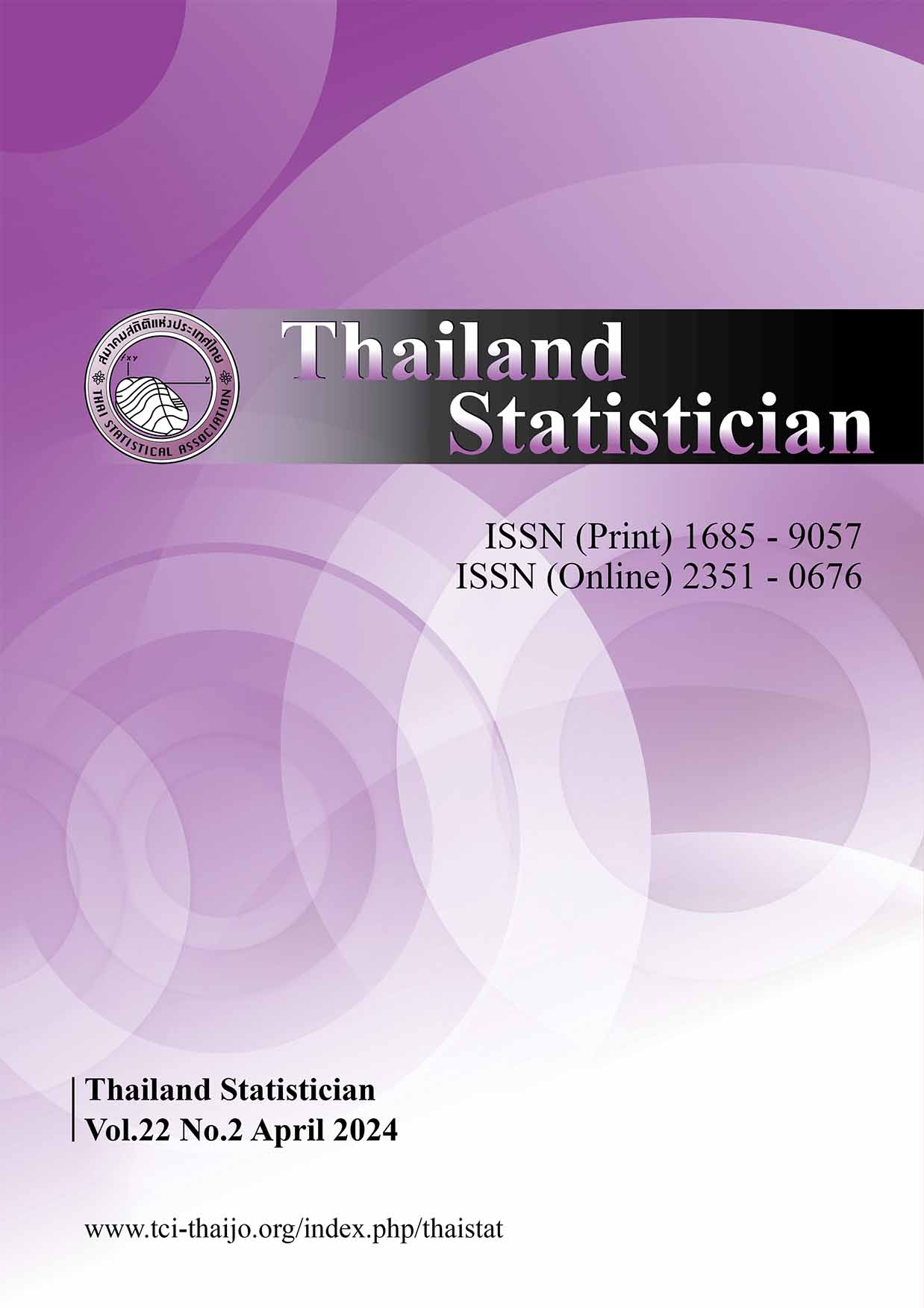Determining the ARL for a Shift in the Mean of a Long-Memory ARFIMA(1, d, 1)(1, D, 1)s Process with Exponential White Noise Running on a CUSUM Control Chart
Keywords:
Average run length, analytical integral equation, numerical integral equation (NIE) methodAbstract
The CUSUM control chart is a well-known statistical process monitoring tool that is sensitive to small-to-moderate shifts in a process parameter. Herein, we provide a solution for the average run length (ARL) for a shift in the mean of a long-memory process with exponential white noise running on a CUSUM control chart based on the analytical integral equation (AIE) approach. Its existence and uniqueness were proven by applying Banach's fixed-point theorem. The numerical integral equation (NIE) method was used to verify the accuracy of the proposed AIE approach by comparing the percentage accuracies for various out-of-control ARL situations. We also recorded their computational times. The results of using the AIE and NIE approaches are in close agreement (percentage accuracy > 95%) but the time required to compute the ARL using the former was significantly shorter. A major advantage of using the AIE approach was in finding the optimal values for reference value (k) and control limit (b) very quickly when the process is in-control. Moreover, their optimal values for the minimum out-of-control ARL for the mean of a long-memory
process with exponential white noise running on a CUSUM control chart are also derived. An illustrative example with real data is given to illustrate the practicability of the proposed method. The practical scenario involves analysing natural gas futures prices using the AIE method on the CUSUM control chart in order to track changes in stock prices, which is the point in making profitable decisions for investors.
References
Acosta-Mejía CA, Pignatiello JJ, Rao BV. A comparison of control charting procedures for monitoring process dispersion. IIE Transactions. 1999; 31: 569-579.
Abujiya M., Riaz M, Lee M.H. Enhanced cumulative sum charts for monitoring process dispersion. PLoS ONE, 2015; 10(4): 1-22.
Bagshaw M, Johnson RA. The effect of serial correlation on the performance of CUSUM tests. Technometrics. 1975; 16(1): 103-112.
Brook D, Evans DA. An Approach to the probability distribution of CUSUM run length. Biometrika. 1972; 9: 539-548.
Bualuang D, Peerajit W. Performance of the cusum control chart using approximation to arl for long- memory fractionally integrated autoregressive process with exogenous variable. Appl Sci Eng Prog. 2022; 16(2): 1-13.
Champ CW,Rigdon SE. A comparison of the Markov chain and the integral equation approaches for evaluating the run length distribution of quality control charts. Commun. Stat. Simul. Comput. 1991; 20(1): 191-203.
Granger CWJ, Joyeux R. An introduction to long memory time series models and fractional differencing. J. Time Ser. Anal. 1980; 1(1): 15-29.
Hawkins D. Cumulative sum control charting: An underutilized SPC tool. Qual. Eng. 1993; 5: 463-477.
Hosking JRM. Fractional differencing. Biometrika. 1981; 68(1): 165-176.
Knoth S, Frisén M. Minimax optimality of CUSUM for an autoregressive model. Stat. Neerl. 2012; 66(4): 357-379.
Koshti VV. Cumulative Sum Control Chart. International Journal of Phisics and Mathematical Siences. 2011; 1(1): 28-32.
Lu CW, Reynolds MR. CUSUM charts for monitoring an autocorrelated process. J Qual Technol. 2001; 33(3): 316–334.
Osei-Aning, R., Saddam A.A.: Muhammad, R.: Mixed EWMA-CUSUM and mixed CUSUM-EWMA modified control charts for monitoring first order autoregressive processes. Qual Technol Quant Manag. 2017; 14(4): 429-453.
Page ES. Continuous inspection schemes. Biometrika. 1954; 41(1-2): 100-115.
Page ES. Cumulative sum charts. Technometrics. 1961; 3: 1-9.
Pan JN, Chen ST. Monitoring long-memory air quality data using ARFIMA model. Environmetrics. 2008; 19: 209-219.
Peerajit W, Areepong Y, Sukparungsee S. Numerical integral equation method for ARL of CUSUM chart for long-memory process with non-seasonal and seasonal ARFIMA models. Thail Stat. 2018; 16(1): 26-37.
Paichit P, Exact expression for average run length of control chart of ARX(p) procedure. KKU Sci J. 2017; 45(4): 948-958.
Peerajit W, Areepong Y, Sukparungsee S. Explicit analytical solutions for ARL of CUSUM chart for a long-memory SARFIMA model. Commun Stat Simul Comput. 2019; 48(4): 1176-1190.
Peerajit W, Cumulative Sum Control Chart Applied to Monitor Shifts in the Mean of a Long-memory ARFIMAX(p, d*, q, r) Process with Exponential White Noise. Thail Stat. 2022; 20(1): 144-161.
Phanthuna W, Areepong Y. Analytical solutions of ARL for SAR(p)L model on a modified EWMA chart. Math. Stat. 2021; 9(5): 685-696.
Rao BV, Disney RL, Pignatiello JJ. Uniqueness and convergence of solutions to average run length integral equations for cumulative sum and other control charts. IIE Transactions. 2001; 33(6): 463-469.
Shewhart, WA. Economic control of quality of manufactured product. Milwaukee: American Society for Quality Control; 1980.
Sofonea M, Han W, Shillor M. Analysis and approximation of contact problems with adhesion or damage, New York: Chapman and Hall/CRC; 2005.
Sunthornwat R, Areepong Y. Average run length on CUSUM control chart for seasonal and non-seasonal moving average processes with exogenous variables. Symmetry. 2020; 12(1): 1-15.
Wieringa, JE. Statistical process control for serially correlated data. Ph.D. [dissertation]. University of Groningen, Netherlands, 1999.
Downloads
Published
How to Cite
Issue
Section
License

This work is licensed under a Creative Commons Attribution-NonCommercial-NoDerivatives 4.0 International License.




